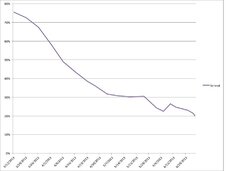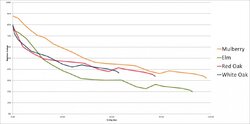Back in early March a neighbor had a small elm taken down, and I took the opportunity to conduct a drying experiment. I oven-dried a sample slice, weighing it before and after, and established the initial moisture content at 76%. I also weighed a medium-sized split, and have continued weighing it every week or so, regularly calculating the average moisture content. Today that split of elm hit 20%.

This method is much more accurate than an electronic meter, but the result probably isn't typical; the split was sitting on top of a stack in a very sunny spot, only about three feet from a SE-facing brick wall that holds a lot of heat. Also, 20% is the average moisture content. It may be 10% on the outside and 27% in the middle, but overall it's 20%. For comparison I'm also tracking the drying of one split each of red oak, white oak and mulberry. None of those is ready to burn quite yet.

This method is much more accurate than an electronic meter, but the result probably isn't typical; the split was sitting on top of a stack in a very sunny spot, only about three feet from a SE-facing brick wall that holds a lot of heat. Also, 20% is the average moisture content. It may be 10% on the outside and 27% in the middle, but overall it's 20%. For comparison I'm also tracking the drying of one split each of red oak, white oak and mulberry. None of those is ready to burn quite yet.







